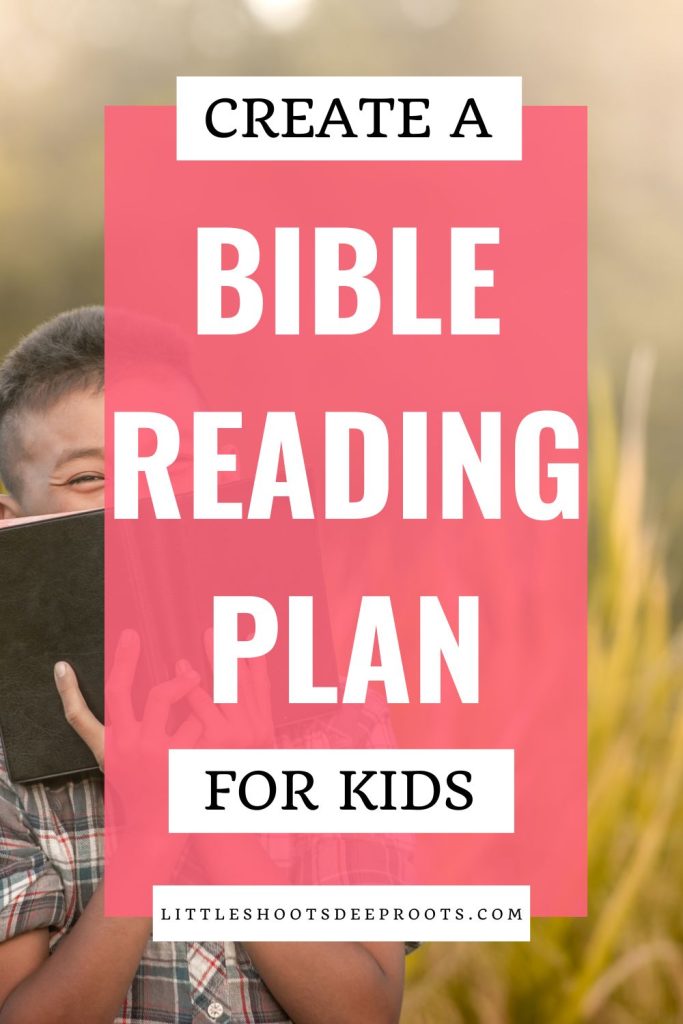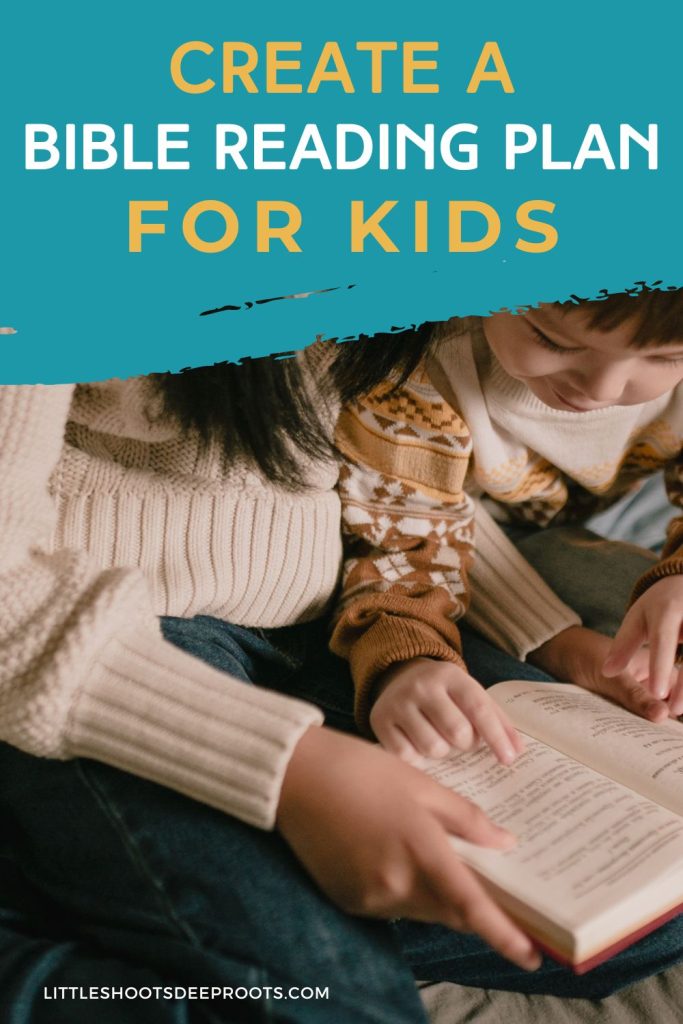A Guide to the Perfect Bible Reading Plan for Kids

As an Amazon Associate I earn from qualifying purchases. This post may contain affiliate links. See my full disclosures, Terms of Use, and privacy policies on my “privacy” page. I never recommend a product I don’t love.
As parents or guardians, we have a great responsibility in shaping the faith and character of our children. Reading the Bible is a great way to lay a solid foundation for their spiritual growth and development. But with so many options available, it can be overwhelming to choose the right Bible reading plan for kids. That’s why we’ve put together this comprehensive guide to help you create a personalized Bible reading plan that will meet your children’s spiritual needs.
The Bible is a treasure trove of stories, wisdom, and inspiration, and as Christians, we believe it’s literally the Word of God. It’s never too early to introduce kids to this incredible book and help them develop a love for reading and understanding it. A Bible reading plan for kids can be an excellent way to engage them in the Word of God and help them learn more about their faith. Let’s explore some fun and creative ways to get kids involved in reading the Bible!

Before you create a Bible reading plan, it’s important to understand your children’s needs and interests. This will help you tailor the plan to their individual needs and make it more engaging and enjoyable for them.
Some questions to consider include:
- How old are your children?
- What are their spiritual interests and goals?
- How much time do they have available for Bible reading each day or week?
- What is their learning style? Do they prefer visual aids, hands-on activities, or simply reading?
Once you have a good understanding of your children’s needs, you can start thinking about the type of Bible reading plan that would work best for them.
One specific need to consider is the need for Bible reading to be relevant to your kids. The Bible can sometimes seem overwhelming and boring to kids, but with the right approach, reading the Bible can be a fun and exciting experience. Here are some tips to help make Bible reading a part of your kids’ daily routine:
- Choose a Bible that’s appropriate for their age: Get your kids a colorful, illustrated Bible that’s written in simple, easy-to-understand language. Here’s my favorite Bible for young readers.
- Make it interactive: Encourage kids to take notes, draw pictures, and ask questions about what they’re reading. If you’re reading together, have them re-enact what they just read, using whatever toys or random props you have on hand. Use this free poster to find ideas on how to make it interactive.
- Read together: Make Bible reading a family activity by reading a passage together every day.
- Make it a game: Turn Bible reading into a fun game by challenging kids to find specific verses, or asking them questions about what they read.
Not only is a Bible reading plan for kids a great way to make the experience of reading the Bible more enjoyable, but it also has numerous benefits. Here are some of the most significant advantages of a Bible reading plan for kids:
- Strengthening their faith: A Bible reading plan helps kids develop a deeper understanding of their faith and strengthen their relationship with God.
- Improving their reading skills: Regular Bible reading helps improve kids’ reading comprehension and vocabulary skills.
- Building character: The Bible is full of stories and teachings that can help kids get to know the deep love God has for them. Over time, they’ll fall in love with God and grow in fruits of the Spirit, which are positive character traits we love to see in kids, such as honesty, kindness, and self-control.
There are many different Bible reading plans available, each with its own unique approach. Some popular options include:
- Book-of-the-Bible plans: These plans help kids read through a specific book of the Bible, in small sustainable chunks at a time. Check out this reading plan on the book of Daniel.
- Topical plans: These plans focus on specific themes or topics, such as the Armor of God, Easter, or God’s promises.
- Character plans: These plans focus on the life of Biblical characters, such as this one on the life of Joseph or this one on 5 courageous women of the Old Testament.
- Devotional plans: These plans include a daily devotional reading along with Bible passages, like this devotional on the fruit of the Spirit.
- Reading through the Bible in a year: This plan involves reading a portion of the Old and New Testament each day, with the goal of reading the entire Bible in a year. (I don’t recommend these for more kids, unless they’re really keen on reading, because it’s A LOT of reading. Most adults can’t even finish these Bible-in-a-year plans!)
When choosing a Bible reading plan for your kids, it’s important to consider their age, spiritual interests, and attention span. For example, younger children may benefit from a simpler plan with shorter passages, while older kids may enjoy a more in-depth study of a specific theme or book of the Bible.
In addition to choosing the right Bible reading plan, you can also incorporate other tools and resources to make Bible reading more engaging and enjoyable for your kids. Some ideas include:
- Using colorful Bibles with illustrations or study notes (here are some suggestions)
- Adding hands-on activities, such as coloring pages or crafts
- Encouraging discussion and reflection with questions or journaling prompts (such as the ones in this Mother and Son Prayer Journal)
- Using apps or websites with interactive features, such as videos, quizzes, and games

Q: How often should kids read the Bible?
A: The frequency of Bible reading will vary depending on your child’s age, attention span, and interests. Some kids may enjoy daily reading, while others may prefer a weekly or bi-weekly plan. The important thing is to find a frequency that works well for your child and stick with it. Keep it SHORT and SIMPLE at first, and only grow its length and depth when your child is ready for it.
Q: What if my child struggles with reading or understanding the Bible?
A: If your child is having trouble with reading or understanding the Bible, read it WITH them! You can also consider using other resources such as audio Bibles, videos, or children’s Bible storybooks. You can also encourage them to ask questions and discuss their thoughts with you or a trusted adult.
Q: What’s the best age for kids to start a Bible reading plan?
A: There’s no specific age to start a Bible reading plan for kids, but it’s recommended to start when they can read and understand simple text. You can always start with toddlers by reading a storybook Bible to them instead of them just reading on their own. Here are my recommended storybook Bibles.
Q: How long should a Bible reading plan be for kids?
A: The length of the Bible reading plan for kids can vary depending on their age and attention span. It’s best to start with short, manageable sections and gradually increase the length as they get older.
Q: What should I do if my kids don’t seem interested in Bible reading?
A: Be patient and persistent! Try different approaches, such as making it a fun game or reading together as a family, until you find what works best for your kids.
A Bible reading plan for kids can be a fun and engaging way to introduce them to the Word of God. With the right approach, kids can develop a love for reading the Bible and reap the numerous benefits that come with it. Whether it’s through interactive activities, family reading time, or a fun game, there are many creative ways to make Bible reading a part of your kids’ daily routine. By starting a Bible reading plan for kids today, you can help them develop a deeper understanding of their faith and strengthen their relationship with God.





